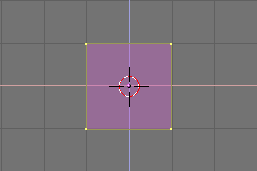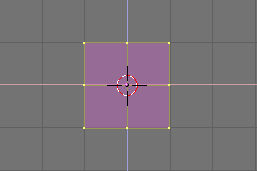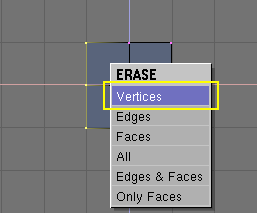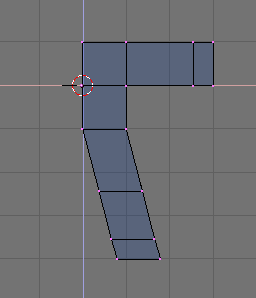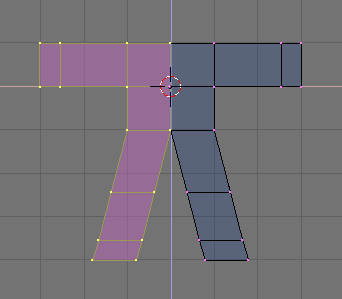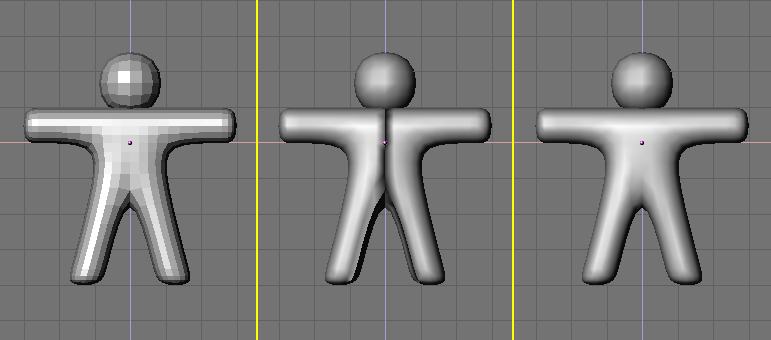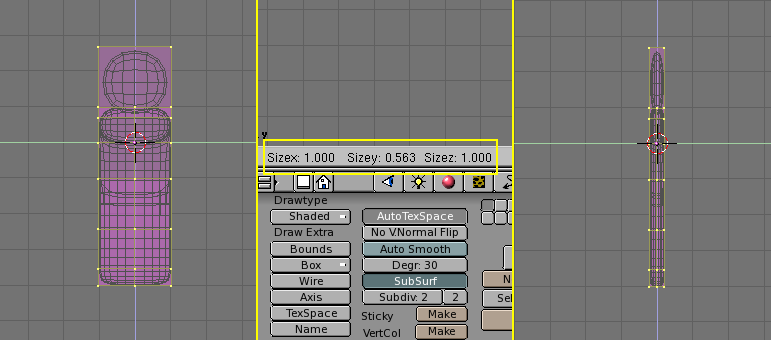Build the body
Turn to front view with NUM 1 and add a cube by pressing SPACE and selecting menu ADD, submenu Mesh, sub-sub-menu Cube. In the folowing we will say SPACE>>ADD>>Mesh>>Cube for short for these kind of actions. A cube will appear Figure 4. A newely added mesh is in a particular mode called Edit Mode in which you can move the single vertices comprising the mesh. By default all vertices are selected (yellow) all edge selected (dark yellow) all faces selected (pink).
We will call the Gingerbread man "Gus". Our First task is to build Gus' body. This will be done by working on our cube in Edit Mode with the set of tools Blender provides. To have a look at these tools push the button showing a square with yellow vertices in the Button Window Figure 5. There is a keyboard shortcut for this, F9.
Now locate the Subdivide button and press it once Figure 6. This will split each side of the cube in two, creating new vertices and faces Figure 7.
With your cursor hoovering on the 3D window press AKEY. This will de-select all. Vertices will turn pink, edges black and faces blue. Now press BKEY the cursor will change to a couple of orthogonal gray lines. go above and to the left with respect to the cube, press LMB and, while keeping it pressed, drag the mouse down and to the right so that the gray box which will appear will encompass all the leftmost vertices. Now release the LMB. This sequence, which let you select a group of vertices in a box is summarized in Figure 8.
 | Box Select |
|---|---|
In many occasions there may be vertices hidden behing other vertices. This is the case, our subdivided cube has 26 vertices, yet you can see only nine because the others are hidden. A normal RMB click selects only one of these stacked vertices, whereas a Box select selects all. Hence, in this case, even if you see only three vertices turning yellow you have indeed selected nine vertices. |
Now press XKEY and, from the menu that pops up select Vertices to erase the selected vertices Figure 9.
 | Undo |
|---|---|
Beware, for performance issues Blender does not have an Undo function, at least not the one everyone thinks to as an Undo function. In any case this is not a real miss since there are many ways to recover mistakes. One of this is that there is a Mesh Undo function, this works only in Edit Mode and returns the mesh to the state it had when the Edit Mode was entered in. You switch in and out of Edit Mode by pressing TAB. You might then wish to switch out from EditMode every time you did one of our modelling step correctly, and then switch back in. ANd press UKEY to turn back to the last correct mesh in case of necessity. Also, pressing ESC in the middle of an action nullifies the action, reverting to the previous state. We will talk of other Undos in the following. |
Now Box Select with the sequence you just learned the two topmost vertices (Figure 10, left). Press EKEY and click on the Extrude menu entry which appears to extrude them. This will create new vertices and faces. The newly created vertices are free to move and will follow the mouse. Move them to the right.
To constrain the movement horizontally or vertically you can click MMB while moving. The movement will then be constrained horizontally if you were moving more or less horizontally o vertically otherwise. You can swich back to unconstrained movement by clicking MMB again.
Move them 1 square and a half to the right, then click LMB to fix position. Extrude again, via EKEY and move the new vertices another half square to the right. Figure 10 show this sequence
Now Gus has his left arm (he's facing us). We will build the left leg the same way by extruding the lower vertices.
Try to get to something like Figure 11.
 | Coincident vertices |
|---|---|
If you extrude and, in the moving process you change your mind and press ESC to recover the extruded vertices will still be there, in their original location! You can move them again, by pressing GKEY or do whatever you want (scale rotate etc.) But you probably don't want to extrude them again. To fully undo the extrusion look for the Remove Doubles button Figure 12. This will eliminate coincident vertices. |
Now it is time to create the other half of Gus, select all vertices (AKEY) and press the 3D Widow toolbar button resembling a cross-hair Figure 13. Now, leave the mouse still. Press SHIFT D to duplicate all selected vertices, edges and faces, SKEY to switch to "Scale" mode, then XKEY followed by either ENTER or click LMB to flip the duplicate. The result is in fig Figure 14
De-select all and re-select all by pressing AKEY twice and eliminate the coincident vertices by pressing the Remove doubles button Figure 12. A bow will appear, notifying you that 8 vertices have been removed.
 | Reference center |
|---|---|
In Blender scaling, rotating and other mesh modifications occur either with respect to the cursor position, or the object center or the baricentrum of the selected items, depending on which of the four buttons in the top center group in Figure 13 is active. The cross-hair one selects the cursor as reference. |
 | Moving the cursor |
|---|---|
Here we have assumed that the cursor never moved from the original position. As a matter of facts you move the cursor by clicking LMB in the 3D window. If you nedd to place the cursor at a specific grid point, as it is in the present case, you can place it next to the desired position and press SHIFT S. This brings up the Snap Menu. THe entry Curs->Grid places the cursor exactly on a grid point. The Curs->Sel places it exactly on the selected object. The other entries moves objects rather than the cursor. |
Use what you have just learned about moving the cursor to place it exactly one grid square above Gus body Figure 15. Add a new cube here (SPACE>>ADD>>Mesh>>Cube). Press GKEY to swithc to Grab Mode for the newly created vertices and move them down, constraining the movement with MMB, for about one third of grid unit Figure 15.
This is a rought figure at best,to make it smoother locate the SubSurf Toggle Button Figure 16 and switch it on. be sure to set the two Num Buttons below to both to 2. Switch out of Edit Mode (TAB) and switch from the current default Wireframe Mode to Solid mode with ZKEY to have a look at Gus. It should look like Figure 17 left. The SubSurf technique computes dinamically a high poly smooth mesh of a low poly coarse mesh.
To make it look smooth press the SetSmooth button Figure 16. Gus will now be smooth but with funny black lines around Figure 17 center. This because the SubSurf is computed using informations about the coarse mesh normals directions, and these can be uncoherent if extrusions and flippings have been made. To reset the normals switch back to editmode (TAB), select all vertices (AKEY) and press CTRL N. Click with LMB on the Recalc normals outside box which appears. Now Gus will be nice and smooth as in Figure 17, right.
Press MMB and drag the mouse around to view Gus from all angles. It is too thick! Switch to side view NUM 3. Switch to Edit Mode if you are not there already, and back to Wireframe Mode ( ZKEY), and select all vertices with AKEY Figure 18.
Now, to make Gus thin, press SKEY and start to move the mouse horizontally. Click MMB to constrain scaling to just one axis. If you now move the mouse toward Gus it should become thinner but remain of its height. You should note on the 3D Window toolbar three numbers giving the scaling factor. After you clicked MMB only one will vary. Press and keep pressed CTRL. The scale factor will now vary in discrete steps of value 0.1. Scale Gus down so that the factor is 0.2 and fix the dimension by clicking LMB.
Switch back to front view and to Solid mode (ZKEY) rotate your view via MMB. Gus is much better!
